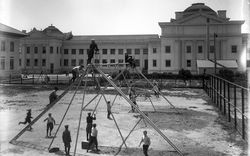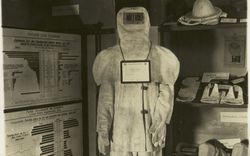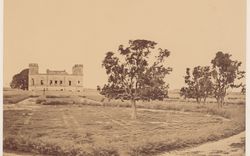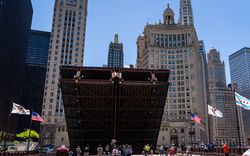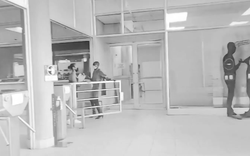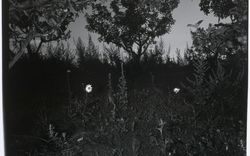Architectures of Dissent
Jola Idowu looks to Chicago and the infrastructure of protest
George Floyd was murdered by Derek Chauvin, a Minneapolis police officer, on 25 May 2020, at 9:25pm.1 Four days later, I found myself amidst a wave of protests in downtown Chicago organized to call attention to the injustice of Floyd’s death.2 Police and protesters clashed in front of Federal Plaza and Trump Tower, but despite numerous reports of police violence, my memory of that day remains shaped by the aftermath of the event more than the chaos itself. I remember moving forward in the hot summer sun as I worked my way out of the city centre to find a route back home. Earlier that night, Mayor Lori Lightfoot had ordered a closure of all exits, trains, and buses traveling through downtown Chicago to prevent people from leaving and entering the protest site. What lingers in my mind is the solitary sound of my feet trudging through the streets and the feeling of being isolated in my own city. I remember feeling fearful and vulnerable: fearful of the prospect of being arrested and taken into custody, vulnerable to the possibility of never going home. I remember being on the phone trying to formulate a plan to escape: “Try another exit!” “Try entering at 50th!” “Try entering at 35th!” The next day, the trains, buses, and streets remained out of operation, while the number of protesters exploded to 20 000.3 People were beaten off bridges and streets, cornered, and arrested in mass numbers by the Chicago Police Department (CPD). Before my eyes, downtown Chicago had transformed into a centre of violence and a tactical environment employed against its constituents. I remember, on my way home on 29 May 2020, saying to my friend, “They tried to trap me. I felt trapped.”
-
Evan Hill et al., “How George Floyd Was Killed in Police Custody,” New York Times, May 31, 2020, https://www.nytimes.com/2020/05/31/us/george-floyd-investigation.html. ↩
-
Martha Bayne, Jason Schumer, and Bea Malsky, “What Happened May 30?” South Side Weekly, 2020, https://protesttimeline.southsideweekly.com. ↩
-
Bayne, Schumer, and Malsky, “What Happened May 30?” ↩
Chicago
Beginning as an outpost of onion farmers and fur traders, Chicago is a city born from a dream. Before its incorporation in the 1830s, speculators saw the Chicago River and its surrounding landscape as the site for the next great American port city, where goods could be stocked and transported between coasts via national infrastructural systems.1 Through technological and demographic changes, Chicago realized the dream envisioned for it, evolving into a city where intra-state flows of circulation—from the Chicago River to railroads and Route 66—profoundly shaped the city’s and the country’s history. Chicago, as a long-term infrastructure hub, has been a focal point for climactic national protests where the macro- and micro-relations between capital, the state, and its citizens become tangible. Its history is not just one of planes, trains, and automobiles, but one of social change, where physical infrastructures are reanimated and subverted as sites of protest for citizens to speak to and act in criticism of the state. Three definitive Chicago protests—the Pullman Strike, the Democratic Convention of 1968, and the George Floyd protest—form a lineage that displays the relationship between activism and urban space, while their aftermath shows how the politics of our cities’ infrastructure can also be employed against its constituents. However, our present reality exposes the speculative possibility for a different status quo, one where protest is not the antagonist, but the norm of urban living by creating a city inclusive of difference and resistance: a city of protest.
-
William Cronon, Nature’s Metropolis: Chicago and the Great West (New York: W. W. Norton, 1991), 23–55. ↩
Railroads and the Pullman Strike
The act of protesting is protected under the First Amendment of the American Constitution, which guarantees the right to organize. However, the First Amendment is not a carte blanche statement; over the years, limitations have been established based on case law, including the restriction of protests or organizing activities if they pose a danger or inconvenience to other citizens, or if they interfere with the legal and constitutional duties of the federal government.1 For the government to curtail protests in these spaces, there must be a disruption of public safety or a threat to the “public good,” otherwise known as a “public nuisance”: actions that significantly impact not only a specific population but the broader public.2 The tension between protest as a right and its potential as a nuisance came to head on a warm June day in 1894, when America went silent. The noise of railroad conductors yelling the final train time and porters shifting bags was absent. Instead, the business of cities, the traffic, and the flow of people around railyards were replaced by the chants of a picket line on the South Side of Chicago in the company town of Pullman.
Built in 1880 as an idyllic, state-of-the-art community for employees of the Pullman Palace Car Factory, a railroad car manufacturer, Pullman Town became a national example of work reform and the intersections of business and civic duty. However, for its residents, Pullman was a different experience, characterized by high rents and stringent laws. Tensions between Pullman ownership and residents reached a boiling point in 1894 when, spurred by a major economic depression and a decrease in sales, George Pullman lowered workers’ wages while increasing rental prices, leading four hundred Pullman workers to walk out and strike after failed negotiations. The subsequent Pullman Strike would likely have remained a local disorder if not for a power-shifting alliance with the American Railway Union (ARU) that expanded the strike to include 250 000 railway workers, placing the country’s train system at a standstill. In response, the Cleveland Presidential Administration quickly mobilized to end the strike, prioritizing their platform of economic interests and industrial growth. However, the issuance of a legal injunction demanded more than the inconvenience of a suspended train system, which did not, by legal terms, satisfy any of the criteria for categorization as a public nuisance.
-
State Historical Society of Iowa, “Protest in America,” n.d., accessed February 28, 2024, https://history.iowa.gov/history/education/educator-resources/primary-source-sets/protest-america. ↩
-
David L. Hudson, “Can You Protest on Public Property? The First Amendment Guide,” n.d., accessed February 28, 2024, https://www.freedomforum.org/protest-on-public-property/.; Institute for Constitutional Advocacy and Protection, “Public-Nuisance Laws,” n.d., accessed February 28, 2024, https://constitutionalprotestguide.org/relevant-federal-and-state-laws/#false-assumption-statutes. ↩
Faced with mounting pressures from both industrialists and President Cleveland, Richard Olney, the U.S. Attorney General and a former rail company lawyer, was hard-pressed to find a legal argument to end the strike. He eventually found his solution by drawing on an unlikely source: the United States Postal Service, a codified right for every American citizen that relies on trains for the delivery of mail. Olney ordered an injunction citing the strike as disruptive to the rights of American citizens and a prevention of the duty of the U.S. government. In turn, Olney placed the right to organize in conflict with the protection of property and infrastructure for the “greater good,” while utilizing the subsequent application of nuisance case law and the legal prohibition of “interruption” or “discomfort” to undermine citizens’ ability to assemble. The legacy of such a decision not only severely limited union and protesting power, but also complicated the ability of people to wield their agency and voice as instruments of social change. This prompted questions about the future role of public discourse within the concept of the public good when juxtaposed against the investments and requirements of the built environment.
Permits, Roads, and the Democratic National Convention of 1968
This relationship between the greater good, infrastructure, and protest has not remained static. New laws and regulations have arisen in attempts to define this complicated connection, with perhaps no mechanism more important than the permit. In the past century, the permit has emerged as the mediating entity between the state’s duty and the rights of its citizens, acting as the municipal document that authorizes protests under specific conditions. While permits are legally mandated to be granted impartially, biases can influence permit decisions, particularly against political viewpoints that challenge established norms or reframe infrastructure as a tool for protest. In these cases, the permit has been oriented as a tool of control, most famously represented in one of the most important and explosive protests in American history: The Battle of Michigan Avenue. It was here that the whole world watched as thousands of young activists made their way to Chicago to protest the Democratic National Convention of 1968.1 The convention was anticipated to be politically contentious due to anti-Vietnam War sentiments—in the months prior, Mayor Richard J. Daley prepared for demonstrators by placing all 11 000 officers of the Chicago Police Department on twelve-hour double shifts, implementing spatial defences around the convention centre, and issuing an 11pm curfew. In July 1968, protest groups such as the Yippies and the National Mobilization to End the War in Vietnam (MOBE) were denied applications for permits by the City of Chicago, with the judge ruling that the city could deny protest permits if they threatened the public comfort of the city. However, fearing accusations and lawsuits of political discrimination under the First Amendment and to appease activists, city officials granted one permit for a protest at the Grant Park bandshell on 28 August. What began as a peaceful rally of 15 000 people quickly escalated into a confrontation between police and protesters when MOBE began to march towards the convention site. In response, the Deputy Police Superintendent ordered officers to clear the streets by any means necessary before protesters could reach the convention hall. The following “Battle of Michigan Avenue” was captured on film and broadcast to over ninety million households, depicting scenes of protesters being violently beaten and arrested in front of the Democratic Party headquarters.2
Streets, assumed as the physical manifestation of public life and urban commerce, became the battleground where private and public interests, protests and property protection, clashed. As the hub of Chicago’s economy, tourism, and transportation—a reality that persists to this day—the disruption to Michigan Avenue and downtown had the potential to reverberate through the cityscape. Police intervened in this space to “defend” the city’s infrastructure from protest activities and reinstate a business-as-usual status quo. Following the Democratic Convention, the City of Chicago, through the implementation of new legal barriers and surveillance measures, created a multi-level system of monitoring to control the use of streets for public assembly. New regulatory policies provided means of arrest and fines for “public endangerment” and included a mandate for protest permits which authorized police intervention if protesters violated municipal orders of protection for the built environment.
-
“The whole world is watching” was a chant repeated by protesters during the 1968 Democratic Convention. ↩
-
Dean Blobaum, “Chicago ’68: A Chronology,” January 27, 2024, http://www.chicago68.com/c68chron.html. ↩
This is the other side of the legacy of the ‘68 Democratic Convention, where legal mechanisms like permits and nuisance lawsuits have been mobilized to frame and act against dissent. Here, permits were used to inherently control rather than facilitate discourse, producing a public sphere, as philosopher Nancy Fraser argues, where powerful entities mould public good to suit private interests, perpetuating inequities.1 Instead, Fraser proposes a reorientation towards a pluralistic public sphere, free from hierarchical constraints, to ensure equitable use of infrastructure that challenges private interests. This transformative vision demands a shift from a facade of peace based on conformity to genuine acceptance of diverse viewpoints and actions that confront state policies through active engagement with the built environment.
-
Nancy Fraser, “Rethinking the Public Sphere: A Contribution to the Critique of Actually Existing Democracy,” Social Text, no. 25/26 (1990): 56–80. ↩
Bridges and the George Floyd Protests
By law and by sentiment, infrastructure can be a public space, a public form, and a site of public movement. It creates a place where citizenship and the negotiation of rights unfold through physical intervention alongside the intangibility of the state. During the George Floyd protests of 2020, protesters infiltrated public spaces on bridges and streets to speak out against Floyd’s murder. After many hours of marching through the streets of downtown Chicago, I watched as the protest took a violent turn. The police escalated their tactics, resorting to physical confrontations. Protesters were beaten with clubs, struck with shields, and corralled into police cars right before my eyes. Meanwhile, chaos erupted on Michigan Avenue. People smashed windows of commercial stores, and looting began. As protests continued along Michigan Avenue and resulted in damage to nearly every storefront, many across the city began to wonder if there was a different way forward. On the one hand, there were residents who saw looting as inevitable and the attention paid to it as a distraction from the purpose of the protest, especially when many of the businesses affected were major corporations. Some also saw power in this destruction. According to journalist H.R. Lossin, “…[destruction] is coercive. It is an actual threat to order and a very real threat to capital. In other words, the ability to cause actual damage is a source of power.”1
On the other hand, many saw looting as protesters going “too far.”
-
R.H Lossin, “In Defense of Destroying Property, The Nation, June 10, 2020, https://www.thenation.com/article/activism/blm-looting-protest-vandalism/. ↩
In response, Mayor Lori Lightfoot and the CPD implemented strict measures to control the movement of protesters, including the closure of streets and highways leading to the city centre, the deployment of the National Guard, and the lifting of bridges. Chicago’s thirty-some bridges serve as iconic symbols of the city’s architecture and are crucial for connecting its landscape and enabling the flow of people and goods across the Chicago River. The strategic manipulation of these bridges and their spatial arrangement was used to isolate protesters and restrict movement throughout downtown Chicago, facilitating police arrests and crowd control. The protesters were transformed from active political participants into bodies pushed into submission, with the divide-and-conquer tactic turning a unified force into fragmented groups. By the end of the day, 204 people were arrested, one person died from a police gunshot wound, six were wounded, and many others were injured, leaving many Chicagoans grappling with the ongoing tension between preserving order and fostering inclusive civic engagement.
What these three protests illustrate is that encouraging plurality means rejecting the homogeneity of public spaces and embracing the potential for change and disruption, despite its consequences. The risk of destruction is inevitable, but destruction also paves the way for new possibilities. As I stood in downtown Chicago that day, I felt both the risk and the potential for a new world to emerge, one that transcended any imposed restrictions. The laws that govern our daily lives are in need of a radical reimagining that acknowledges the city as an arena for protest and dissent—one that is willing to risk dismantling established norms to amplify the voices of the marginalized, and where people can congregate in the streets, trains, or bridges to shut down the city and demand a new order. By instead viewing public policy and law through the lens of a city of protest, we can foster a new urban ethos that challenges the conventional view of cities as mere functional entities designed for efficiency and economic growth, and instead reimagines urban spaces as dynamic arenas where citizens actively participate in shaping their collective future and acknowledge that diverse viewpoints and dissenting voices are essential for a vibrant and inclusive society. By taking this approach, we have the power to reshape our cities into spaces where change and disruption are not feared but embraced—a new world that accommodates both unity and discord, forging a path towards inclusivity and justice for all.





